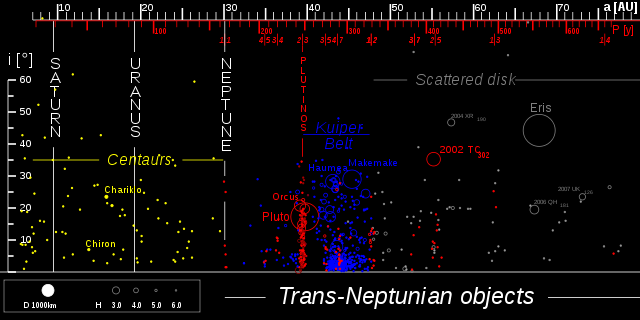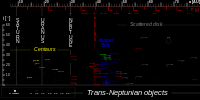
File:TheTransneptunians 73AU.svg

| |
This is a file from the Wikimedia Commons. Information from its description page there is shown below.
Commons is a freely licensed media file repository. You can help. |
![]() ✓ The source code of this SVG is valid.
✓ The source code of this SVG is valid.
Contents |
Summary in English
The distribution and classification of the trans-Neptunian Objects. Generated by a program written by Eurocommuter.

See also the high resolution (richer content) version.
Main graph
The characteristics of an object in the graph represent:
- Distance along horizontal axis
- the object's orbital semi-major axis a in Astronomical Units
- orbital period in years (in red)
- Distance along vertical axis - the object's orbital inclination i in degrees
- Size of the circle - the object’s size relative to others:
- for a few large objects, the diameter drawn represents the best current estimates
- for all the others, the diameter of the circle represents the absolute magnitude H of the object.
- vertical bars mark orbital resonances with Neptune; 1:1 marks the position of Neptune’s orbit (and its Trojan asteroids), 2:3 marks the orbit of Pluto and plutinos.
Families
To highlight other resonant objects, all of them are plotted in red.
Data source
Minor Planet Centre Orbit database (MPCORB) as of 2008-10-05. Resonant orbits' classification from MPEC Circular 2008-S05 (2008-10-01). Diameter estimates include Stansberry et al. (Spitzer). See refs in the related articles.
Derivative works
Derivative works of this file:
Description en français
La distribution et les familles des transneptuniens Graphique généré par un programme écrit par Eurocommuter.
Graphe principal
La position d’un objet représente
- le demi axe majeur (rayon moyen) de son orbite a en in au (l’axe horizontal)
- l’inclination de son orbite i en degrés (axe vertical).
Le diamètre du cercle montre la taille relative de l’objet aux autres. Pour quelques grands objets, le diamètre représente la meilleure estimation connue. Pour tous les autres, le diamètre du cercle représente la magnitude absolue de l’objet.
Les positions des résonances avec Neptune sont marqués par des traits verticaux; 1:1 marque la position de l’orbite de Neptune (et ses Troyens), 2:3 marque l’orbite de Pluton (et ses lunes) etc.
Familles
- Centaures ne sont pas formellement membres des transneptuniens
- La Ceinture de Kuiper regroupe
- Objets classiques, cubewanos, en bleu
- Objets résonants en 2:3 et 1:2, en rouge
- Objets épars, en gris
Pour repérage facile tous les autres objets résonants sont en rouge.
Source des données
Base de données MPCORB au 1er decembre 2007, sauf pour la classification des orbites résonantes où le Minor Planet Circular 2007-W54 a été utilisé.
Licensing
|
File usage
Metadata
Schools Wikipedia and SOS Children
Wikipedia for Schools was collected by SOS Children's Villages. SOS Childrens Villages believes education is an important part of a child's life. That's why we ensure they receive nursery care as well as high-quality primary and secondary education. When they leave school, we support the children in our care as they progress to vocational training or higher education. There are many ways to help with SOS Childrens Villages.

